Article's Content
Podcasts have become the new cornerstone of modern content marketing. Every week, millions of listeners tune in, and smart brands are turning that attention into measurable growth.
The opportunity is massive. According to an Adobe survey of 903 business owners, companies that launched podcasts saw an average 38% increase in revenue, with 78% reporting their podcast met or exceeded ROI expectations.
Yet most brands treat a podcast episode as the finish line. They record, publish, promote once, and move on. The conversation ends, and so does the content’s potential.
Podcast repurposing changes that. One recording can spark dozens of assets across blogs, video, social, and email that continue working long after the episode airs.
In this article, you’ll learn how leading companies repurpose their podcasts to scale content output, why the model works, and how to apply it to your workflow. Whether you already have a show or are planning one, this framework will change how you think about content ROI.
What Is Podcast Repurposing and Why Should You Do It?
Podcast repurposing is the process of turning your long-form audio content into derivative assets that you can share across multiple channels.
For example, you can take an hour-long interview and repurpose the content into:
- Blog posts that cover key points from the conversation
- Ebooks or whitepapers that expand on core topics
- Social media posts that share bite-sized insights
- Audiograms that showcase short, engaging audio clips
If your episode is recorded on video, you can extend its reach even further by:
- Uploading the entire episode on YouTube
- Isolating shorter segments for YouTube Shorts and TikTok
Each of these formats extends an episode’s reach and lifespan beyond a single upload.
Great content can’t live up to its potential without a great distribution strategy.
Repurposing builds that distribution engine, giving your podcast more surface area and more opportunities to be discovered.
What Systematic Repurposing Delivers
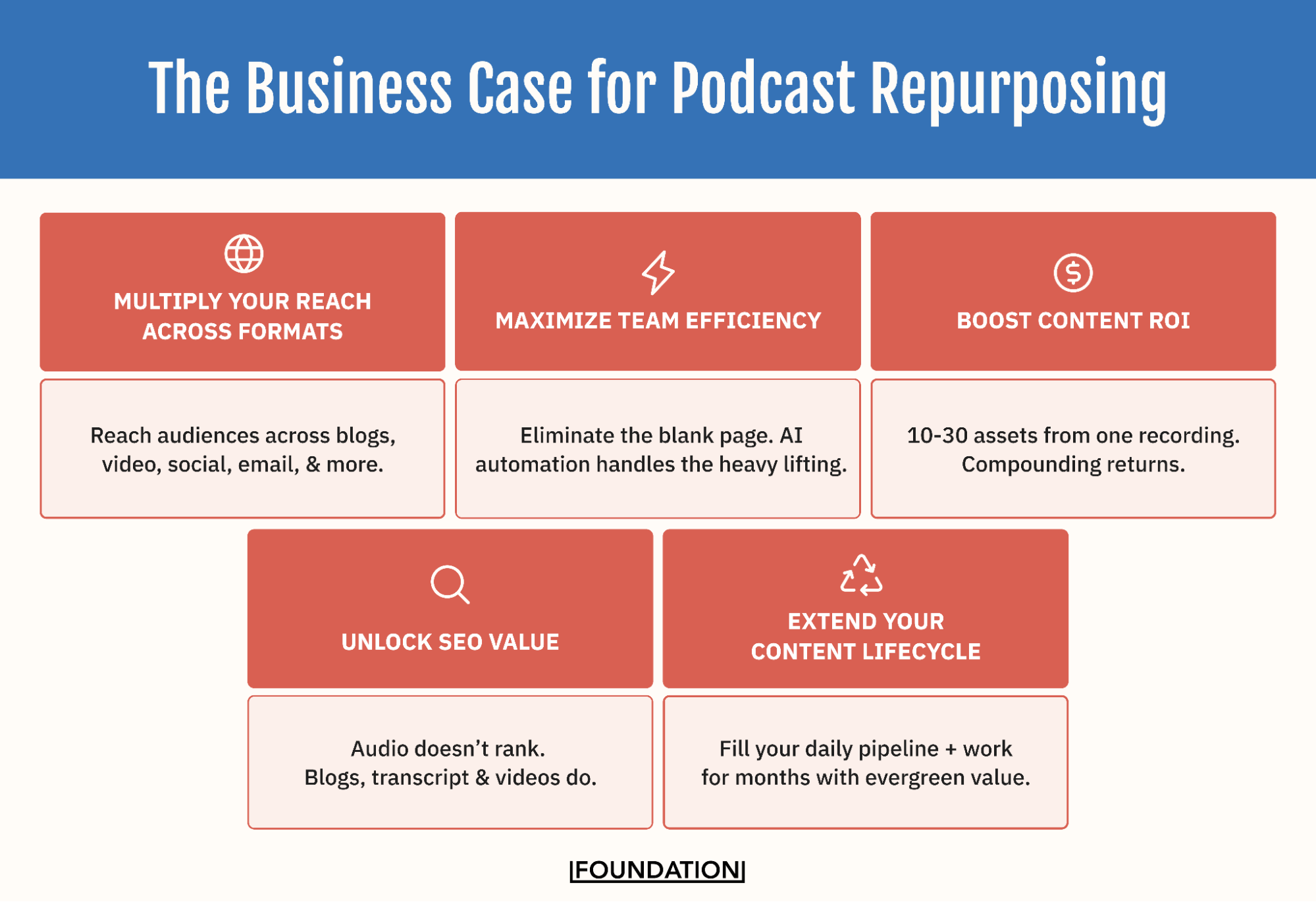
Systematic repurposing allows you to:
- Expand Reach. Derivative assets create touchpoints across multiple platforms and audience preferences. Each piece has standalone value while pointing back to the full episode.
- Maximize Team Efficiency. Creating high-quality content from scratch is expensive, even with AI. Research, ideation, outlining, drafting, and editing all take time (and money). Repurposing lets your team focus on creativity, platform optimization, and audience engagement instead of starting from a blank page.
- Boost Content ROI. Producing a podcast isn’t cheap. You need guests, prep, editing, and promotion. When an episode is used once, ROI stops there. When it fuels dozens of new assets for your content supply chain, each piece extends the return on that initial investment.
- Unlock SEO Value. Google can index podcasts, but it’s easier to compete in search with blog posts, web pages, and YouTube videos. Repurposing turns audio gold into discoverable, rankable content that drives organic traffic long after release.
- Extend Your Content Lifecycle. A podcast may spike the week it drops, then fade. Repurposing changes that trajectory. One episode can fuel your content engine for weeks, giving you enough assets to maintain a consistent presence without constantly creating from scratch.
The data makes a clear business case: podcasts deliver measurable revenue impact. Extending that reach through repurposing multiplies the return.
But understanding why repurposing works is only half the equation. The real question is how to actually do it.
5 Key Ways to Repurpose Podcast Content
There are many ways to repurpose a podcast, but five approaches consistently deliver results: transforming episodes into written articles, videos, social media posts, email content, and long-form assets.
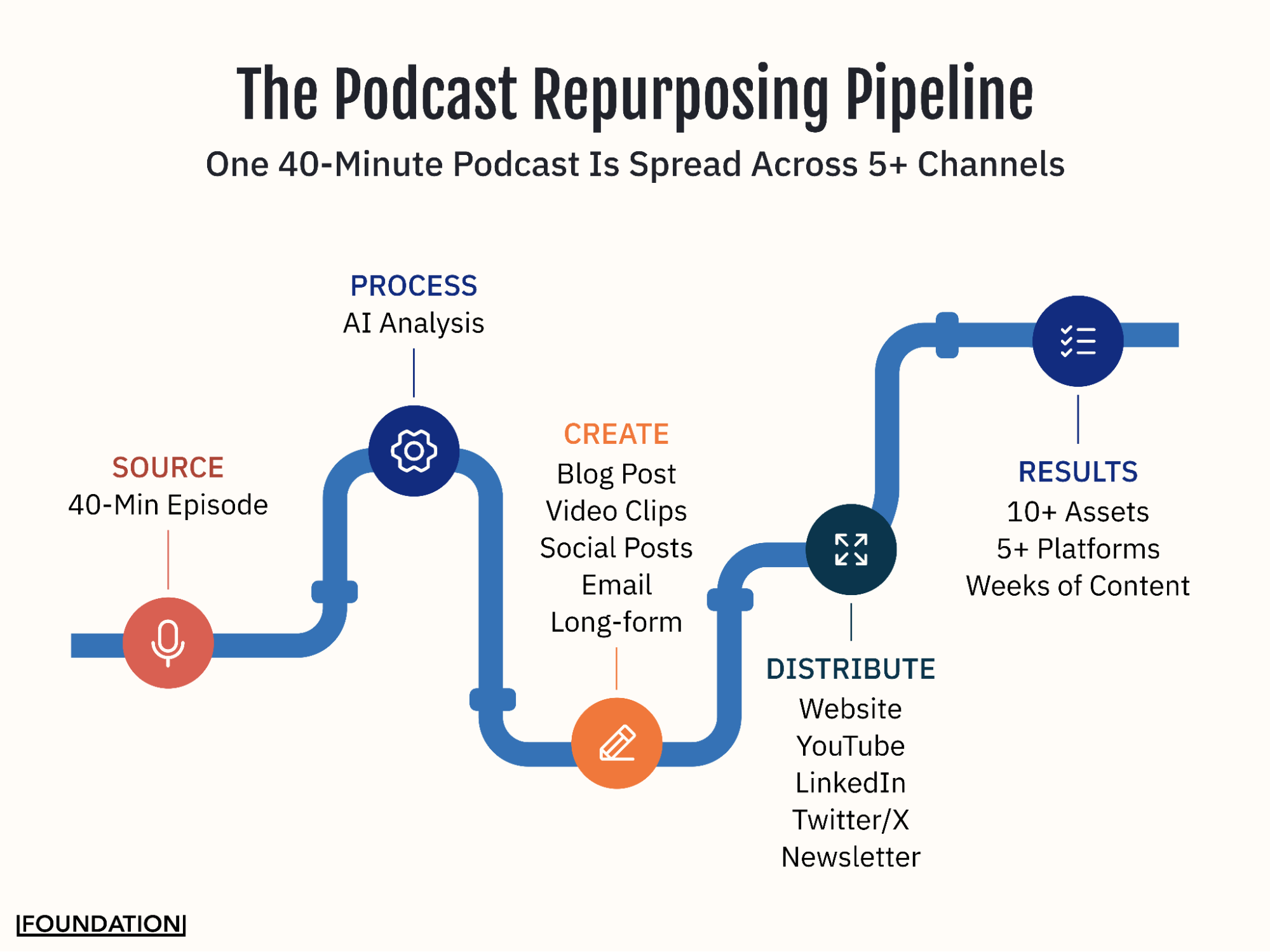
1. Turn Your Podcast Into a Blog Article
Transforming a podcast episode into a blog post is one of the most effective ways to extend reach. It unlocks SEO value, serves readers who prefer text, and creates a permanent home for your ideas.
You can repurpose an episode into:
- A full transcript with light editing, section headers, and context. This is the lowest-lift option because transcription tools handle most of the work.
- A Q&A post that highlights an interview or expert discussion. This works especially well when your guest is a recognized authority or has a compelling personal story.
- A narrative article that distills the conversation into key takeaways and insights. This requires more editorial work but creates content that reads naturally and can rank for competitive keywords.
To speed up the process, AI podcast repurposing tools can generate search-optimized blog posts from your transcripts, complete with meta descriptions, suggested keywords, and proper formatting.
HubSpot’s Marketing Against the Grain podcast does this well. They turn in-depth conversations about topics like AEO and SEO evolution into editorial content that reinforces their thought leadership across formats.
Once your written content is live, you can extend its visibility through video.
2. Turn Your Podcast Into Video Content
YouTube is now the top podcast platform, capturing 39% of total consumption, almost double Spotify’s share at 21%. Video has become essential for discoverability and engagement.
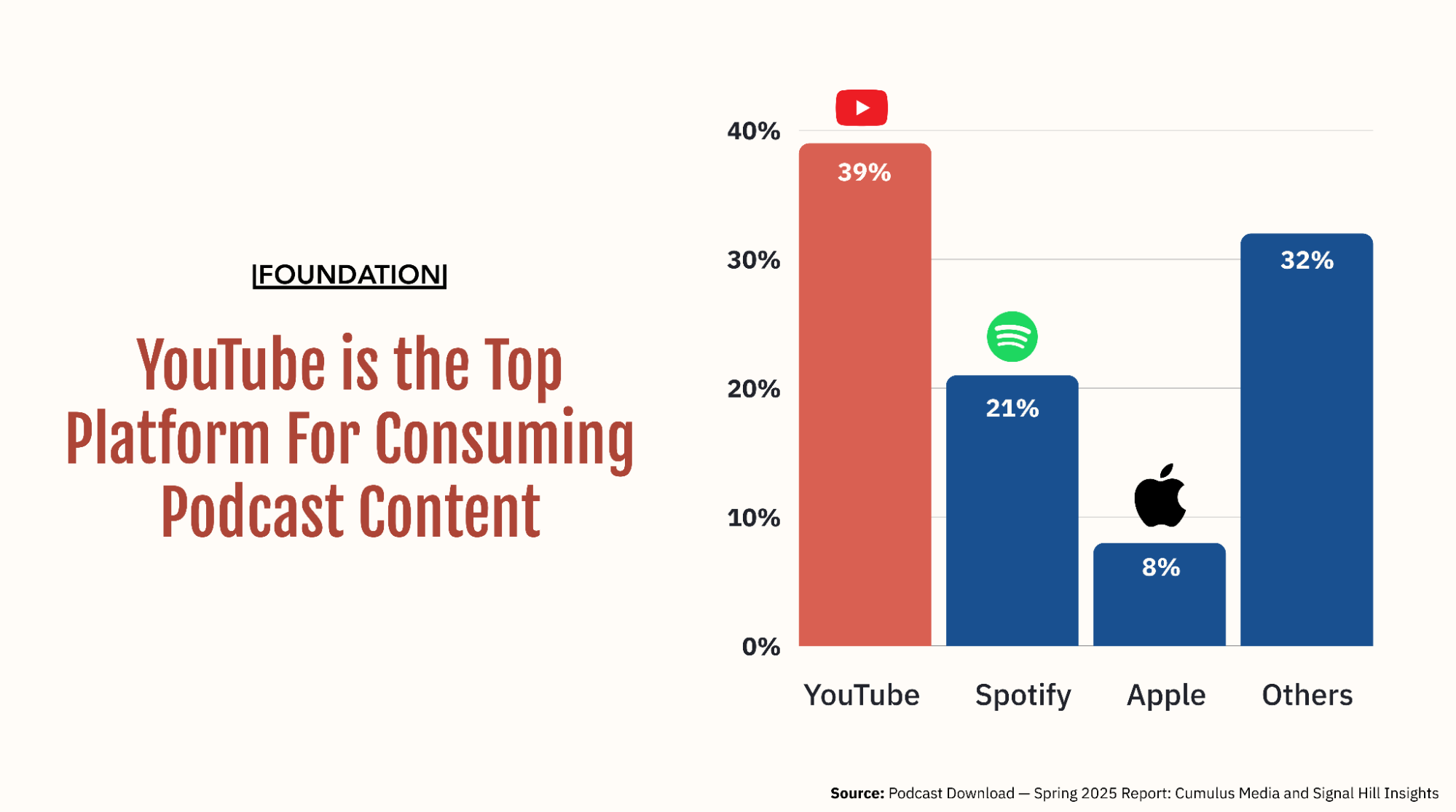
Here’s how to extend your podcast into video content:
- Record The Session. Use Zoom, Riverside, or a basic studio setup to capture audio and video. Even a simple camera and a clean backdrop are enough to create a full-length episode that can live on YouTube.
- Create Short Clips. Share 30–60 second snippets or audiograms as teasers across platforms. Focus on your most compelling moments like controversial takes, surprising statistics, or actionable advice. Add captions (essential, as most social video plays without sound) and brand elements.
- Use Live Recordings. Stream your sessions on LinkedIn or YouTube to build real-time engagement, then repurpose that content for your podcast feed and other channels.
Reid Hoffman‘s Masters of Scale is an excellent example of repurposing podcasts for video. They distribute full episodes and bite-sized shorts across YouTube, where they’ve built 137K subscribers and over 4 million views, Apple Podcasts, Spotify, and their website to maximize reach.
Video extends the life of each conversation and helps you reach audiences who prefer watching over listening. And smart brands are catching on: the Adobe study also found that 25% of business owners rank podcasts as their #1 content priority, second only to YouTube videos.
Once you’ve captured strong video assets, the next step is to extend their reach across social platforms.
3. Turn a Podcast Into Social Media Content
Social is where podcast (and any other type of long-form) content stays alive. Repurposing helps you show up often and stay relevant without repeating yourself or exhausting your creative team.
Effective social repurposing includes:
- Quote Graphics: Visually branded posts with bold, resonant quotes pulled directly from the conversation. Choose statements that spark curiosity, challenge assumptions, or deliver immediate value. Design them in your brand’s style so they’re instantly recognizable in the feed.
- Key Takeaway Threads: “5 Lessons from [Guest]” posts that deliver value upfront and link to the full episode. This format works especially well on LinkedIn. Lead with the insights, add brief context, then include a soft CTA to the full episode.
- Discussion Prompts: Pull a bold claim or hot take and ask your audience to weigh in. This turns passive listeners into active participants and increases reach through engagement.
- Platform-Specific Assets: Threads for Twitter/X, carousels for LinkedIn and Instagram, and short recaps optimized for each platform’s algorithm and audience preferences. What works on LinkedIn (professional, data-driven) differs from what works on Instagram (visual, aspirational).
- Post-Launch Drip: Share multiple clips and quotes over several days or weeks to reach different audience segments. Someone who misses your Monday post might catch your Wednesday clip or Friday quote card.
If you’re looking for more inspiration, top B2B marketing podcasts like Foundr, Hypergrowth, Online Marketing Made Easy, and Noah Kagan Presents use Instagram and LinkedIn to share short, high-performing clips from their episodes.
Once your podcast content is circulating on social, bring it closer to home with email. It’s where your audience is most likely to listen, click, and engage.
4. Turn a Podcast Into Email Content
Email is high-intent and high-leverage. Repurposing here keeps your brand top-of-mind with subscribers who already opted in and are primed to engage.
Here are a few ways to repurpose podcast episodes for distribution via email:
- Episode Recaps: Short, three-to-five-bullet summaries that include a compelling quote or insight and a link to the episode. Subscribers should feel they got value from the email itself.
- Newsletter Inserts: Add podcast clips or quotes in a “What We’re Listening To” or “Podcast Highlight” section of your regular newsletter. This keeps your podcast visible without requiring a dedicated send.
- Narrative-Style Repurposing: Reframe the episode as a personal email or founder insight. This works especially well for thought leadership content where you can extract a core idea and expand on it in a more conversational style.
- Automated Series: Package past episodes into a themed email drip for new subscribers. This evergreen sequence introduces new audience members to your best content and builds engagement from day one.
Email is a key part of our own podcast repurposing strategy at Foundation.
Our weekly newsletter includes a section dedicated to promoting the latest episode of The Ross Simmonds Show. Each feature includes a ~150-word summary highlighting key discussion points and a link to the episode.
Subscribers get value whether they click through or not, which builds trust and keeps the podcast top-of-mind without being salesy.
Once you’ve built engagement through email, you can level up by transforming podcast insights into long-form, high-value content that drives leads and revenue.
5. Turn a Podcast Into Long-Form Assets
This is where repurposing becomes a revenue engine. Podcasts can power your highest-value content and gated assets that drive leads.
Consider these approaches:
- Ebooks & Guides: Combine themed episodes into a gated download with added structure and visuals. If you’ve done a series on content marketing, bundle those insights into a comprehensive guide with additional frameworks and examples.
- Whitepapers or Reports: Support podcast insights with original research or expert-backed data. This elevates your content from an opinion to an authoritative resource and creates premium assets for lead generation.
- Webinars or Live Events: Revisit a popular episode topic with a follow-up AMA or expert panel. This extends the conversation, creates new content, and deepens engagement with your most interested audience members.
- Books: When your library is deep enough, expand it into a book that establishes long-term authority. Many successful business books started as podcast episodes organized and refined into a cohesive narrative.
Once again, the Masters of Scale podcast is a great example. The team repurposed standout episodes into a book that captures the podcast’s most compelling stories and lessons.
You’ve seen what’s possible at a tactical level. Now here’s how a leading B2B brand turns those tactics into a repeatable system.
Putting it All Together: 6Sense’s Podcast Repurposing Pipeline
6Sense, an ABM platform with a strong thought leadership strategy, runs multiple podcasts, including Revenue Makers and Science of B2B. Their approach shows how to capture full value from every episode.
In one recent episode, Lies My Marketing Experience Told Me, featuring Liam Moroney from Storybook Marketing, 6Sense turned a 17-minute conversation into a multi-format campaign:
- A dedicated episode webpage with SEO-optimized copy and embedded video for on-site engagement, which included:
- Episode Overview: Sets context and hooks interest immediately.
- What You’ll Learn: A Clear value proposition stated upfront.
- Memorable Quotes: Shareable soundbites pulled directly from the conversation.
- Practical Takeaways: Bulleted action items for time-pressed readers.
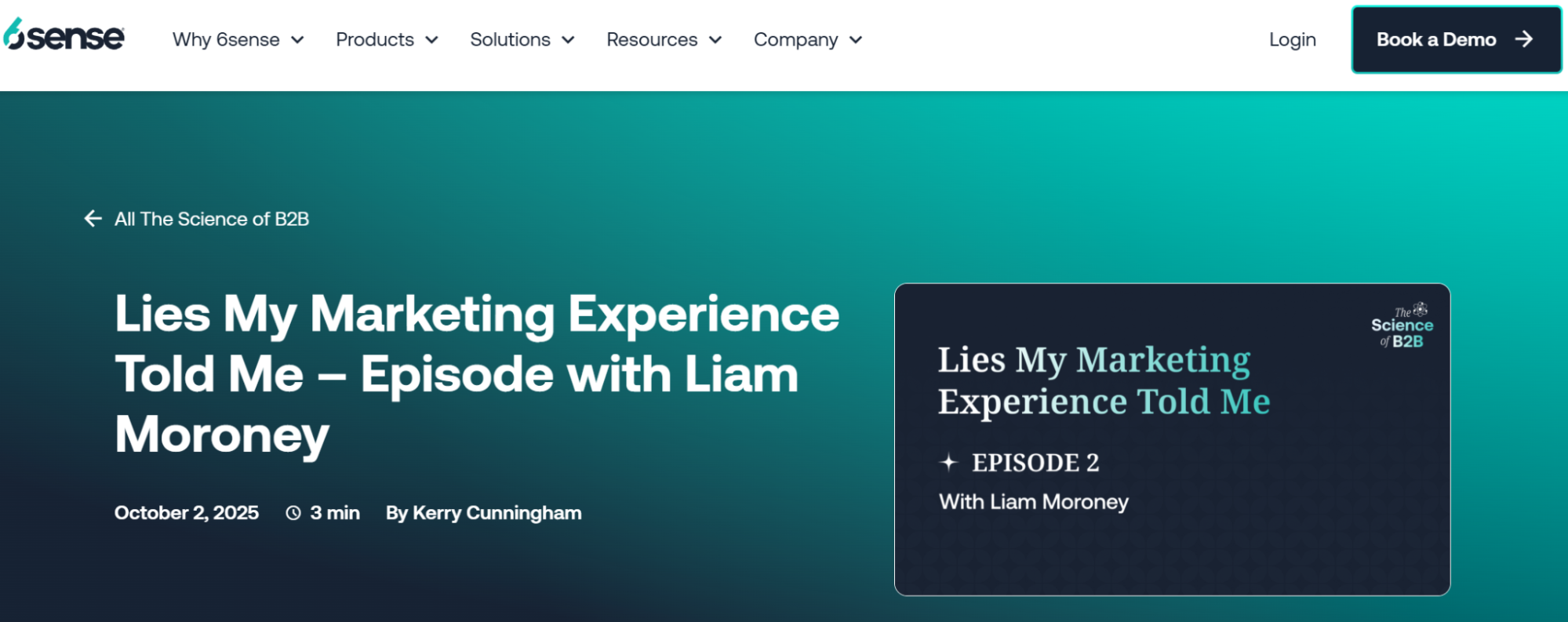
- A compelling 45-second clip from the conversation, posted on the company’s LinkedIn page, is driving engagement and awareness across their professional network.
The payoff from one 17-minute conversation:
- An SEO-optimized webpage ranking for relevant keywords
- Embedded video content for visual learners
- Social engagement and visibility across LinkedIn
- Scannable takeaways for executives short on time
- Multiple entry points for different audience preferences
This example captures the power of podcast repurposing in action. Each asset meets the audience where they already spend time, and together they extend the reach and lifespan of a single conversation.
For 6Sense, this approach is a repeatable system that keeps every recording working long after it’s published. By planning distribution from the start, they’ve turned their podcast workflow into an always-on content engine.
How Top Brands Execute Repurposing (Best Practices)
Repurposing content is an effective, cost-efficient way to increase reach. But that doesn’t mean it’s easy. Each asset needs to provide value to your audience and connect with larger business goals. These five best practices show how to do it well.
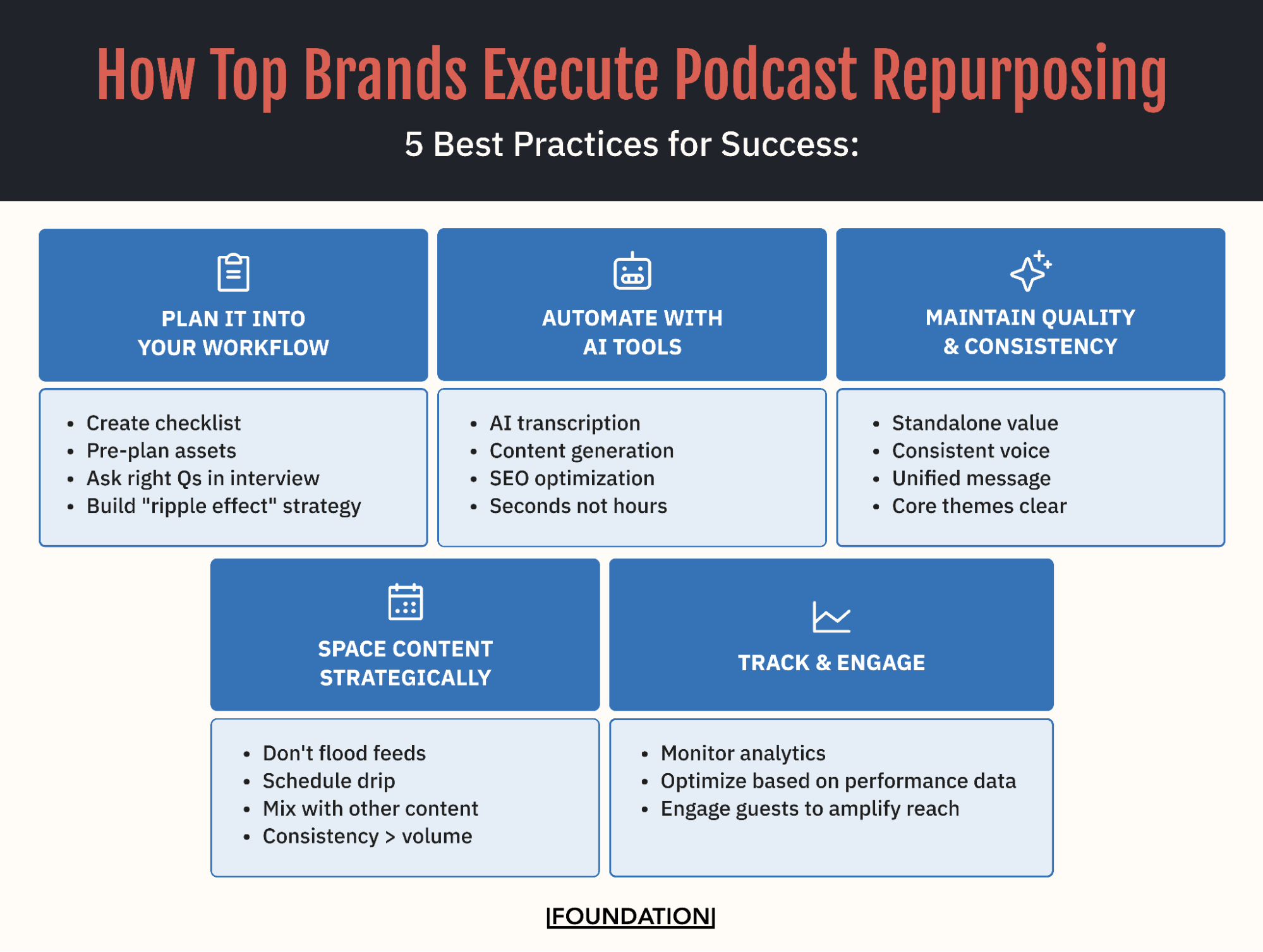
1. Plan Repurposing Into Your Workflow
The pros don’t treat repurposing as an afterthought. From the moment they plan a podcast episode, they’re also planning how it will be repackaged.
For example, if you’re recording tomorrow, have a checklist ready:
- Get a transcript
- Identify two blog angles
- Prepare three quote images
- Edit three video clips
- Schedule five LinkedIn posts
Many teams create a content distribution checklist so every episode follows the same process. This ensures consistency and helps interviewers ask questions that lead to those juicy quotes and insights.
It’s what Ross calls the “Content Relay” — a ripple effect that turns one recording into ongoing results.
2. Use AI Tools and Automate What You Can
The best brands invest in tools that save time and scale results. They use AI transcription to get raw text in minutes, often with speaker identification and timestamps for easy extraction.
Tools like Distribution.ai can transform the repurposing workflow with:
- Accurate automated transcription
- SEO-optimized blog generation with meta descriptions and keywords
- Multi-format content generation (social posts, email summaries, quote graphics)
- Processing that takes seconds instead of hours

Automation handles the heavy lifting, freeing your team to focus on voice, story, and strategy — the work that drives differentiation.
3. Maintain Quality, Authenticity & Message Unity
Repurposing multiplies your reach, but it also multiplies the risk of inconsistency. Every asset should provide standalone value while connecting naturally to the main narrative.
Here’s a good test: If someone sees a social post or reads the blog without knowing the podcast exists, do they still get something meaningful? If yes, your repurposing works.
Keep tone and style consistent with your brand. If your podcast is fun and witty, let that come through in the repurposed text and captions. Consistency builds recognition and trust across every format.
4. Space Content Strategically (Don’t Flood)
Repurposing widely doesn’t mean publishing everything at once. Too much content in a short period can overwhelm your audience.
Plan releases across channels.
For instance, in the week after launch, publish the blog, two or three social posts, and one email. The following week, share a clip or follow-up post. Consistency beats volume. You want a steady stream, not a one-day deluge.
5. Track, Learn & Engage Your Community
The top brands treat content repurposing as an evolving system. They monitor performance: which formats get the most engagement, which topics drive the most traffic, which channels generate the best conversions.
Over time, this data lets them optimize. For instance, you might find your audience really loves quick one-minute “advice” videos but doesn’t care much for long transcripts. Or that your text LinkedIn posts do better than image posts. Use those insights to double down on what works.
Beyond analytics, involve your guests and community. The guest who appeared on your podcast has a vested interest in that content. Send them those quote graphics (“Hey, we pulled this awesome quote of yours from the show — feel free to share!”) or clips. Many will repost to their network, extending your brand’s reach.
Some teams go further, hosting quick post-episode Q&As or community AMAs to keep the conversation going and surface new insights for future content.
Increase the Impact of Your Podcasts with a Distribution Strategy
Once the system is in place, the difference becomes clear. Brands like 6Sense plan for repurposing and create a consistent process that keeps delivering results. Each episode carries ideas forward, sparking new content and conversations that build momentum over time.
Repurposing turns that consistency into a competitive edge. When every recording feeds your wider strategy, the impact grows with each episode.
Ready to put that process to work? Try Distribution.ai’s AI Podcast Repurposing Tool to turn each recording into content that lasts.







